The MacBook Pro Review (13 & 15-inch): 2011 Brings Sandy Bridge
by Anand Lal Shimpi, Brian Klug & Vivek Gowri on March 10, 2011 4:17 PM EST- Posted in
- Laptops
- Mac
- Apple
- Intel
- MacBook Pro
- Sandy Bridge
Thermals and Power Consumption
The new MacBook Pros have the potential to draw more power than the previous generation. Despite being built on a 32nm process, the new 15 has twice the cores of last year's model—there's no question that it can draw more power under a full load.
I measured maximum power consumption at the wall using the same power brick and a fully charged battery. I chose two high-load scenarios: Cinebench 11.5 and Half Life 2. The former will fully load all CPU cores while the latter ramps up CPU and GPU usage.
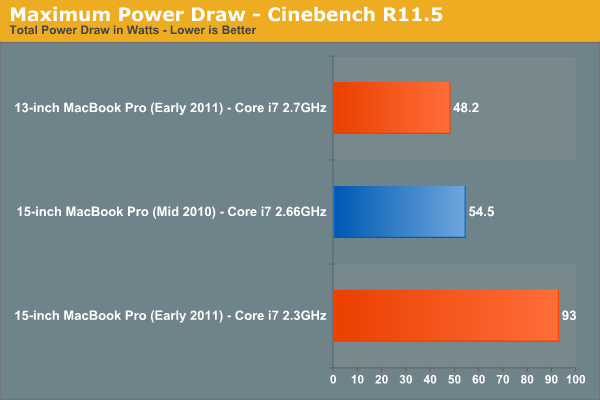
Under Cinebench the new quad-core 15-inch MacBook Pro draws 70% more power at the wall than last year's dual-core model. This shouldn't be surprising as Cinebench scales nearly perfectly with core count—twice the cores should result in nearly twice the power draw. The scaling isn't perfect since we are dealing with different architectures and a number of factors such as display remain static. The new 13-inch MacBook Pro isn't as worrisome, it has 88% of the power usage of the high end 2010 15-inch MBP and 81% of the battery capacity.
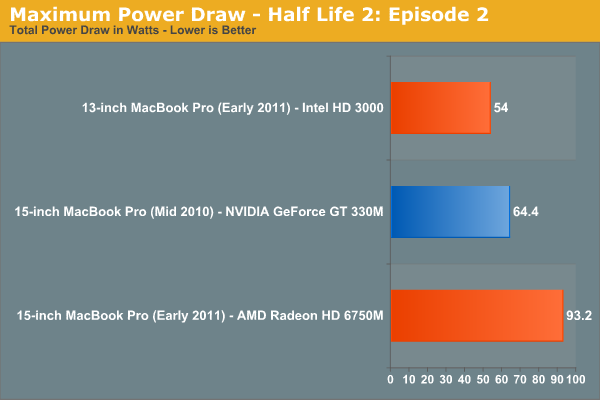
The Half Life 2 comparison is not quite as bad, although the new 15-inch MBP still uses 45% more power under full load compared to the previous generation. These numbers tell you one thing: although the new MBP is significantly faster than its predecessor, it can also draw significantly more power. Running the same workload the new MBP shouldn't have any problems lasting as long as the old MBP on battery, but running a more aggressive workload will result in shorter battery life as a result of the higher max power consumption. In other words if you use the higher performance to do more, you can expect your battery to last proportionally less than the 2010 MBP.

The 15-inch MBP uses an 85W power adapter (left) and the 13-inch MBP uses a 60W adapter (right)
Drawing more power also has another unfortunate side effect: the bottom of the chassis gets even hotter than before. I took some crude temperature measurements when I did the 2010 MacBook Pro reviews last year. I pointed an IR thermometer at the center of the bottom of the notebook, right where you'd have your lap, and measured surface temperature in a couple of scenarios.
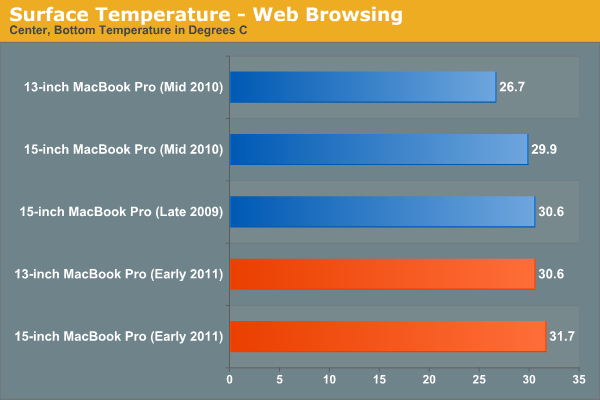
While browsing the web with tons of windows/tabs open I noticed a small but tangible increase in surface temperature of the 2011 15-inch MBP compared to the 2010 model. Even the new 13 is warmer than last year's 15. Under light workloads none of these temperatures are high enough to really be a problem.
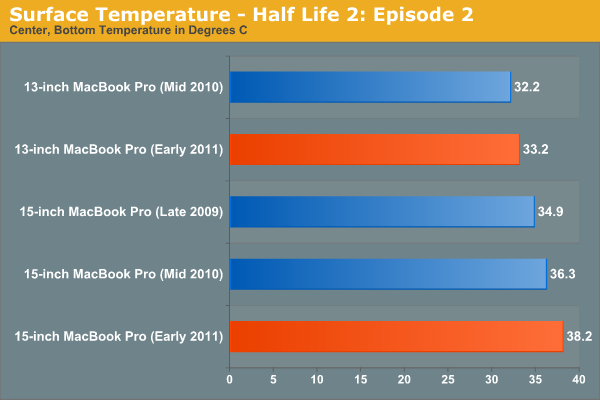
Load up the system however and you start getting into the uncomfortable zone. The new 15 breaks 38C, while the new 13 is actually only marginally warmer than the old 13 thanks to the use of Intel's HD Graphics 3000.
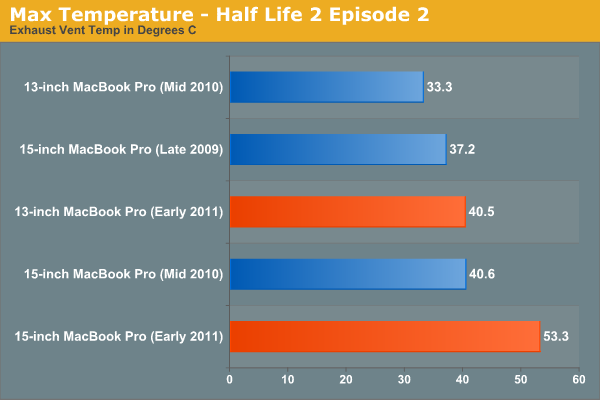
The biggest difference I noticed was the max temperature near the exhaust fan(s) on the notebooks. The new 15 is a whole 13C warmer than last year's model.
There's no way to get around it—if you're going to be using these systems to anywhere near their potential, they are going to get significantly warmer than last year's. Also, as a result, the new systems are noisier. Fans are more likely to spin up and given how small they are, they are quite audible. If this is a deal breaker for you, the best advice I can give you is to wait for Ivy Bridge.

Ivy Bridge will bring mild updates to the Sandy Bridge architecture, an increase in performance but more importantly it'll bring Intel's 22nm process. At 22nm I'd expect somewhat lower power usage than what we're seeing here today. Ivy Bridge is expected to ship in the first half of 2012, with updated MacBook Pros arriving ~2 months post introduction.










198 Comments
View All Comments
robco - Thursday, March 10, 2011 - link
I made the mistake of buying a 15" MBP eighteen months ago and am stuck with a machine that has mediocre graphics and overheats constantly. Don't buy the MBP if you actually use it on your lap. That being said, the only reason I bought it over the MacBook was the dedicated graphics. With the awful performance of the Intel integrated chip, I hope Apple releases a 15" MacBook with the option of dedicated graphics for consumers. I'm not shelling out $2199 just to get something with a decent video card. I wouldn't recommend the 13" at all, as there are several alternatives in the 13-14" range that offer dedicated cards.I fell victim to the hype and now I have a fairly recent machine that can barely handle SC2 and an iPhone that can't make phone calls. Don't make the same mistake. Most of the tasks you can do on a Mac you can do on a Windows PC. Unless you are actually a pro and need a pro-grade machine, don't waste your money. For those who can justify the expense, they are nice machines, but if you actually put them to work, be ready to set them on a cool surface or get a cooling pad. They run awfully hot.
KoolAidMan1 - Thursday, March 10, 2011 - link
My MBP from last year plays SC2 perfectly, above 60fps most of the time which is great. Same with Source games. People on Youtube have already uploaded video playing the Crysis 2 demo on the new MBPs and it looks great.Your machine is almost two years old. Be logical when complaining about performance. Just because your machine is slow doesn't mean that the new ones aren't screaming fast: http://www.pcmag.com/image_popup/0,1740,iid=287468...
The 13" MBP is also decent with the SB IGP. I've seen clips on YT of people playing games even on the slower Macbook Air and it looks good. IGPs have come a long way from where they were in 2009.
robco - Thursday, March 10, 2011 - link
I'm a little miffed that a machine that was so expensive has become outdated rather quickly. I paid a lot just to get dedicated graphics. I could have and should have paid less to get a Windows notebook. I won't make the same mistake again. If you're a consumer and don't need a pro-grade machine but still want good graphics, the MBP is a poor value.The MBA actually handles games better than the new 13" MBP because it still uses the C2D and the NV integrated chipset. Once it switches to Sandy Bridge, performance will drop as it has with the MBP. The only area the MBA is slower than the MBP is raw processing power, graphics and disk access are much faster.
With Apple you can get a notebook that performs well, you just have to shell out $2199 to get it. I did that once, I won't do it again. it just isn't worth it unless you're a pro user who will recoup that cost in a short time. For consumers, it's a waste of money.
ImSpartacus - Thursday, March 10, 2011 - link
If you only needed the graphics muscle, you should've gotten a Windows laptop.Macbooks are for more mobile-minded users. They are thin, strong and have excellent battery life.
If you just need a solid mobile workstation that isn't going to be moved a lot, Windows laptops are a much better value.
SimKill - Friday, March 11, 2011 - link
ODM manufacturers like Clevo and Compal fit your bill perfectly. I got my system in 2009 August and even today I can play most of the games (ofcourse except godforsaken Crysis) at high settings at 1680x1050 (yep, 16:10) It cost me around $1400 but I'm very happy about it so far.SimKill - Friday, March 11, 2011 - link
Dam, they don't have an edit button. The hardware internals are pretty good with copper heatsinks and heatpipes and what not too...erple2 - Friday, March 11, 2011 - link
Hrm. Mac's are more of a semi-pro-grade machine. They still lack some of the important pro-grade features of an actual pro-grade machine. Like a Docking Station. Or a spill-resistant keyboard. Or a thumbprint reader. Or a smart card slot. Or a high-gamut monitor.While they are well constructed, they still don't have some of the critical features required for a good business laptop - they lack the all important OpenGL performance GPUs for wireframe models (among other things). See some of the high end Elitebooks or Thinkpads (which also cost a bit more than these MacBook Pros).
tipoo - Thursday, March 10, 2011 - link
Ah, I just had a dumb, nevermind me.IntelUser2000 - Thursday, March 10, 2011 - link
http://www.anandtech.com/show/4205/the-macbook-pro..."This is a weird one, since the same GPU gave us significantly better performance in the SNB test system."
Oh gee, I wonder why. The SNB test system used quad core and the Core i5 2410M is a dual core. Quad vs. Dual does have some impact.
Anand Lal Shimpi - Thursday, March 10, 2011 - link
It does have some impact, but not in this case. The HD 3000 is actually GPU bound in those tests - not to mention that most games aren't quite so well threaded that 2 v 4 cores should matter.Take care,
Anand